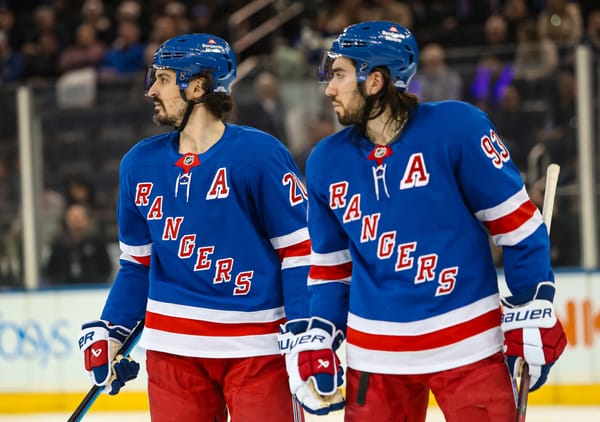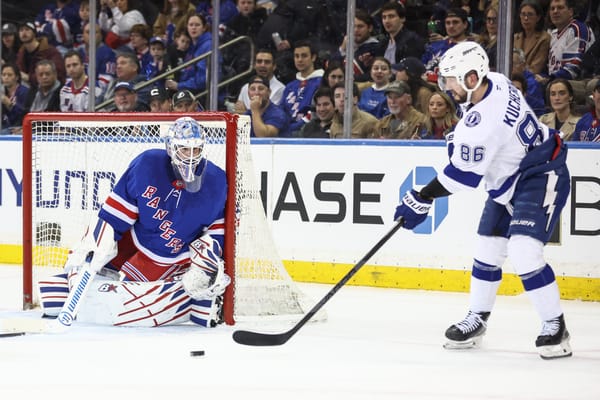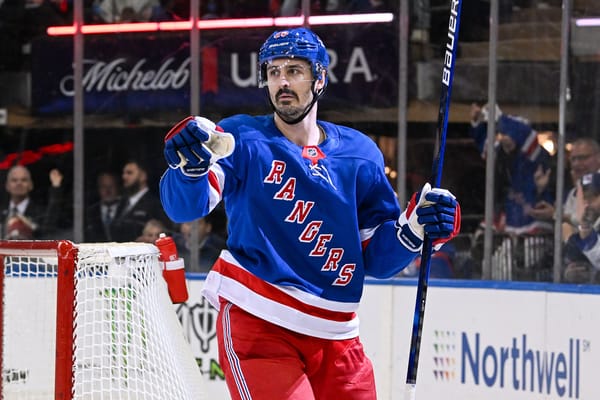Notes and Thoughts on the Rangers Rookies Through November
Let’s talk about the kids
Colorado Avalanche defenseman Cale Makar was recently named the NHL’s rookie of the month for November. Makar had 16 points in 14 games for the Avs — seven goals and nine assists. As of Nov. 30, Makar has 26 points in the first 26 games of the 2019-20 season, making him an early favorite to win the 2020 Calder Memorial Trophy as the NHL’s rookie of the year.
Of course, the Rangers have no shortage of rookie skaters in their lineup this season. It’s hard to remember the last time that the Blueshirts had this many first-year players filled with so much potential on the ice. Now that we’re in the early days of December, we have a good sample size to reflect on the kind of impression that these rookies have made thus far.
Adam Fox
Among Rangers skaters who qualify as rookies this season, it’s safe to say that Fox has made the smoothest adjustment to the NHL game. Remember, Fox had 48 points — 31 of which were primary — in 33 games last season as a junior at Harvard. He looked like a man playing among boys at the Traverse City Prospect Tournament before the season began and has definitely measured up to even the most lofty expectations with his play in the NHL thus far.
Through November, Fox leads all Rangers rookie skaters in scoring with 14 points in 25 games. The only NHL rookie d-men who have been more productive this season are Makar and Quinn Hughes of the Vancouver Canucks. It’s also worth noting that Fox is second only to Makar in goals scored among rookie blueliners.
Fox’s most frequent defensive partners at 5-on-5 this season have been Ryan Lindgren and Brady Skjei and his numbers have looked great with both of them. Through the first quarter of the 2019-20 season, there is definitely a case to be made that he’s not only been the Rangers’ most impressive rookie, but also the team’s best defenseman.
Kaapo Kakko
After he notched two points in his first nine NHL games it was clear that Kakko was adjusting not only to the NHL, but also to his role in the Rangers’ lineup.
“He’s 18 years old. Twenty-year-old’s go through it,” David Quinn told the New York Post back in October. “The only way guys measure themselves is by points. One of the things every 18-year-old has to do, and he’s no different, is to understand that he has responsibility in all three zones and, you know, scoring goals [are no more] important as preventing them.”
The first 25 games of the Finn’s rookie season have been filled with ups and downs. At times, Kakko seems hesitant to pull the trigger — especially on the power play. His score and venue Rel xGF% and Rel CF% are both the worst on the team among forwards. After starting November with seven points in seven games Kakko hit a five-game scoring drought before picking up a beautiful primary assist on the power play to set up Fox against the Devils.
Kakko and Fox connect on the power play #NYR pic.twitter.com/VRn2teCYrK
— Shayna (@hayyyshayyy) November 30, 2019
You need to be a special player to make plays like that. You also need to be a special player to find ways to contribute at even strength when your most frequent linemates are Brett Howden and Brendan Lemieux. Thus far, seven of Kakko’s 11 points have come on the power play.
To be clear, Kakko’s deployment and linemates aren’t the only reason his underlying numbers have been discouraging — citing them is not an excuse, it’s acknowledging that they are part of the puzzle. Besides, there’s no need to make an excuse for him adjusting to the NHL game when we remember that we’re talking about an 18-year-old who will be 19 in February. Hopefully, as the season progresses, the young winger will gain more confidence both with and without the puck on his stick. His future remains as bright as ever.
Libor Hajek
On a team filled with young players who are doing everything they can to claw their into receiving more ice time, Hajek ranks third among Rangers’ defensemen in 5-on-5 TOI/GP with 15:02. He has played nearly three times the amount of 5-on-5 minutes with Jacob Trouba than he has with his Tony DeAngelo, his second most-frequent D-partner.
Like Kakko, Hajek’s underlying numbers leave a lot to be desired. Trouba has a -0.13 Rel CF% away from Hajek and a -5.20 Rel CF% (score and venue adjusted) with him. The only Rangers defenseman with a worse track record for being on the ice for the ugliest moments in the shot share battle this season is Marc Staal (-8.63 Rel CF%). In other words, the top pair has not been kind to the young Czech defenseman. Then again, things haven’t gone much differently when he’s been paired with other d-men.
Back in October, the Rangers head coach made it clear that there’s a purpose behind pairing Hajek with Trouba. “Libor skates well, he plays with a passion, he’s in your face. When he’s playing with confidence, he makes good plays,” Quinn said. “He’s good down below the goal line getting us out of our own end, whether it be making a good decision, or skating out of his own end. And I think playing with someone like Jacob will give him an opportunity to develop a little bit quicker.”
Hajek, who the Rangers are counting on to develop into a legitimate shutdown defender, has done an admirable job considering how much he’s being asked to shoulder on the top pair. With that being said, he gets caught out of position or is guilty of making a costly error at least once or twice each game. Those gaffes have piled up and have become a small mountain of evidence that suggests he is in over his head on the top pair.
When Staal returns, there’s a definitely a case to be made that Hajek should be sent back down to Hartford.
Ryan Lindgren
The fact that Lindgren has a goal and five assists with the Rangers since being called up to help fill the void left by Staal’s injury is a pretty big deal; he had just 12 points — all assists — in 65 games last season with the Hartford Wolf Pack in the AHL. Thus far, he is averaging 16:23 TOI/GP.
Lindgren has played almost exclusively with Fox, which has definitely helped him pass the eye test in games where the defense as a whole has struggled. However, Fox has been able to have a significantly better impact on the Rangers’ shot share when he hasn’t been paired with his fellow rookie. With Lindgren, Fox has a -5.30 Rel CF%; away from Lindgren, he has an 18.71 Rel CF%. That is quite the disparity.
To be fair to Lindgren, he’s been every bit of the player that the Rangers and their coaching staff want and expect him to be. He plays a simple, straightforward game. He takes the body, he’ll take a hit to make a play, and his discipline hasn’t been much of an issue (-2 penalty differential). Lindgren has the potential to develop into a reliable bottom-pairing NHL defenseman.
All data courtesy of naturalstattrick.com, theahl.com, and evolving-hockey.com.




